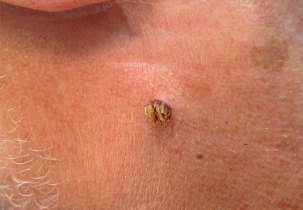
Papillomas in the neck are viral skin growths, a symptom of the papillomavirus. It is invisibly present in the bodies of 90% of the people on the planet. Carriers include young children, newborns, the elderly, young people, and pregnant women. The infection enters the body unnoticed and waits for years for the right moment to attack. The increase, the increase in the number of neoplasms, testifies to the activity.
Causes and symptoms of cervical papillomatosis
The impetus for the development of the disease is a decrease in immunity. The following causes of papillomas on the neck can affect the condition:
- bad habits - smoking, alcoholism;
- diseases of the digestive system;
- severe chronic diseases;
- avitaminosis, anemia;
- long-term medication;
- stress, prolonged depression;
- allergic reactions;
- unbalanced diet;
- Hormonal changes causing menopause, puberty, pregnancy.
The proliferation of papillomas in the neck often causes hormonal imbalances, endocrine diseases, of which diabetes mellitus comes first, followed by hyperthyroidism and obesity.
Papillomas appear on a child's neck due to infection by the mother through the birth canal, feeding, or household contact (through toys, utensils, and other objects used by the virus carrier).
Initially, some items may appear that may change in size and color over time.

How to detect a virus outgrowth:
- the growth is small in diameter;
- the texture is soft, loose;
- shape flat or oblong, convex, papilla on foot;
- color - light as surrounding skin, darkens over time; The appearance of
- is accompanied by itching and burning.
Growth consists of a thin epidermis and can be easily damaged. If integrity is violated, acute pain, itching, bleeding may be observed.
Characteristics of the appearance of many tiny papillomas
Papilloma is a virus that can multiply quickly, infecting the surrounding healthy tissues. This occurs when you touch the infected element with your hands or objects and transfer particles through the body to the mucous membranes.
The neck is an open space, regularly exposed to negative factors. Several strains of the virus like to live in this part of the body. They spread due to lack of personal hygiene, rubbed with collars on clothes, shirts, sweaters, bra straps, and wear scarves. Irritated, rubbed, damaged blood microcirculation skin is a favorable environment for papillomastic infection.
A man is most at risk, less often a woman or a child. Representatives of both sexes and different ages turn to a doctor for help.
Increases the activity of the virus, increased sweating, the use of cosmetic creams that do not allow oxygen into the skin. Altered cells in the epidermis begin to grow rapidly. As a result, a person has many tiny papillomas on the neck and décolleté.
Disease Diagnostics
You should contact a dermatologist to diagnose and prescribe treatment. The doctor performs a visual examination, prescribes an examination.
Growth is initially examined under a dermatoscope to examine the structure.
Papilloma tumors undergo PCR diagnostics to study the DNA of the disease. It allows the strain to be determined and gives an idea of the quantitative content of virus cells in the body. Thanks to the diagnostics, you can pretty much find out the duration of the infection and identify the carrier. Your doctor may find out what is causing the activity of the virus - a concomitant decrease in immunity or worsening of a chronic form.
If a removal decision is made, a biopsy will be ordered at the same time. The resulting tissue is sent for cytological and histological examination. We study the cells, which gives a reliable answer - whether it is a dangerous element or not, how likely the malignancy is to develop into cancer.
According to the obtained results, the doctor prescribes further treatment and excision. It is recommended that papillomavirus carriers be based on periodic testing, PCR diagnostics, to detect altered elements in a timely manner and to prevent disease progression.
Treatment Methods
Therapy is developed individually for each patient. If the papillomas do not have oncogenic status, they can be treated with home-approved medications. In the case of oncogenic proliferation, removal is indicated by subsequent treatment. The option is selected by the physician taking into account a number of factors: the magnitude of the growth, the area of the lesion, the presence of contraindications, and the age of the patient as an adult or child. Once degeneration has begun, the developmental stage of oncology plays an important role.
Drug Medication
Complex treatments are performed to combat neck papillomas. It is important to act on the pathogen from the outside and inside. Medicines prepared in the form of tablets, injections and powders help to increase immunity, the body's resistance.
Medicines should be used strictly according to your doctor's prescription. Any drug has side effects, contraindications. Only a qualified professional should select a drug based on the results of an individual examination of the patient.
Ointments are used to target the virus directly. They block activity, prevent reproduction and reduce size. If the growth is small, it disappears after 1-2 weeks of treatment, up to 8 weeks for large papillomas.
Keratolytics help remove the problem quickly:
- is a medicine that appears as an oily liquid. Gently apply a drop of solution exactly to the element, avoiding spreading on the surrounding tissue. Perform the treatment for 10-45 minutes, at minimum intervals, up to five times. After the procedure, the growth may hurt, turn black, and eventually disappear;
- solid drug. It is designed to remove warts and papillomas without a trace and without pain. Thanks to the pencil, re-infection and the appearance of new tumors on the skin can be prevented;
- is a medicine that appears as a clear liquid. It is guaranteed to remove papillomas of different sizes. A strictly aggressive preparation is used for growth. One week after processing, peeling and drying begin.
The home method of removing warts and papillomas can be used if the test confirmed the good quality of the neoplasms.
Removal in health care facilities
In case of regular damage to large papillomas, it is recommended to remove one of the available medical methods. The following safe and effective techniques are available for surgery:
- laser coagulation. It allows you to get rid of cosmetic flaws without a trace, without pain. The doctor burns the growths without affecting healthy skin. The radiation does not affect the infected epithelium and the papillomavirus does not spread further, relapses are excluded. It is used in cases where there are a large number of small papillomas in a zone. Preliminary examination for oncogenicity is mandatory, histological examination is impossible after evaporation, no substance;
- electrocoagulation. A general method to eliminate various skin growths. The high-frequency current cuts the affected tissue while simultaneously cauterizing the blood vessels. This prevents the disease from reappearing in the treated area. Traces remain after the procedure. Visible for small items. Many papillomas should be excised per session;
- cryodestruction. One of the oldest treatments for dermatological problems. Liquid nitrogen acts on the nerve endings of growth and kills them. After the procedure, color change and crust formation are observed. Pain and ichor may appear. After a few days, complete drying occurs;
- radio waves. A radio knife is used to remove the warts. It operates on the basis of high frequency waves. Due to the lack of skin contact, the risk of recurrence is minimal;
- surgical removal. It is prescribed to the patient when the formation has reached a large scale or when the cells have begun to degenerate into cancers and urgent surgery is needed. The surgeon cuts the papilla with a scalpel, grabbing a small piece of healthy skin. This reduces the risk of developing oncology and blocks papillomatosis.
The method is chosen by the doctor. If necessary, the patient receives local anesthesia.
Recipes for Home Remedies for Cervical Papillomas
If there are contraindications to surgical destruction, you can use the popular experience of HPV treatment. You should consult your doctor before using. A specialist will help you choose the recipe and tell you the precautions. If you do not follow the rules of personal hygiene and do not protect healthy skin, new papillomas will grow at the treatment site, and the removed elements will be larger.
№1Soap (household or tar type). Wash the affected area, hesitate with a thick layer of soap. Apply a polyethylene compress and bandage / adhesive patch to the top. Change until the buildup disappears.
№2Cut off the leaves and stems of celandine. Squeeze the juice with cheesecloth. Treat each element with the resulting liquid. In the first days, repeat the procedure every 3 hours and then once every 3 days. This is a harmful method for pregnant women and young children!
№3Cut or break the aloe leaf and fix it to the sore spot by cutting. Seal the top with polyethylene, bandage. Make a compress before going to bed, clean it in the morning. Repeat until the skin is clear.
# 4Lubricate the papillae with apple cider vinegar. Be careful if you have a lot of papillomas on your neck, do not touch healthy skin. For protection, it is recommended to pre-treat the neck with a greasy cream. Cover the treated growths with adhesive plaster.
An important condition for achieving a stable therapeutic effect is the regular use of prescriptions. Be patient. Homeopathy works for a long time, but reliably.
Danger and Forecasts
If not removed, small papilloma growths can infect the surrounding healthy skin and cover the neck, face, arms, and other parts of the body. Papillomas are fragile, and violation of their integrity can lead to bleeding and the addition of a secondary infection.
Painful, bleeding, swollen tumors are dangerous. These symptoms indicate the development of carcinomatosis - a malignant transformation of the tissues. The virus damages the skin, resulting in uncontrolled growth of epidermal cells and their development into cancer. A trained professional can stop or prevent the process. Regular testing and treatment is a prerequisite for coexistence with papillomavirus.
Body or dark brown warts on the body rarely attract the wearer's attention if they do not impair appearance or are painful. In vain, such inattention to your own body and skin can prove lamentable. Leg growth is the main symptom of papillomavirus. This indicates that the body is infected, the moment it is attacked. It is possible to correct the situation and restore health, but only with complex therapy.















































































